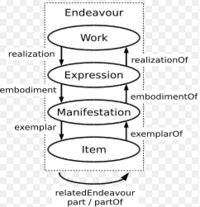Warning:
This wiki has been archived and is now read-only.
FRBR
FRBR
Reviewed by Victor Rodriguez
What is FRBR
FRBR Functional Requirements for Bibliographic Records is a model designed in 1997 to restructure catalog databases to reflect the conceptual structure of information resources. FRBR uses an entity-relationship model of metadata for information objects, instead of the single flat record concept underlying in previous cataloging standards.
Entities in FRBR are categorised in three groups:
- Group 1: What is described by a record.
- Group 2: Who is responsible for the creation, production, etc. of the entity
- Group 3: Event, Object, Place, Concept
It is very well documented, being the Wikipedia page a good starting point, so nothing else to say here.
Why FRBR is of interest to MAWG
It is a very broadly used multi-level representation. Let´s consider an example, to show its four levels of representation: work, expression, manifestation, and item.

In the next example, chosen by myself, a video of "The Marriage of Figaro" may have different levels of annotations.
- Work: distinct intellectual or artistic creation
- The Marriage of Figaro, by Mozart.
- Expression: the specific intellectual or artistic form that a work takes each time it is realized
- Figaro, by Carlo Maria Giulini, with Eberhard Wächter, Elisabeth Schwarzkopf, Anna Moffo, Giuseppe Taddei, Fiorenza Cossotto, Coro and Orquesta Philharmonia (Emi, 1960).
- Manifestation: the physical embodiment of an expression of a work
- Giulini's Figaro, released in Audio CD (1960)
- Giulini's Figaro, released in Video VHS (1985)
- Giulini's Figaro, released in Video DVD (2002)
- Item: a single exemplar of a manifestation
- Giulini's Figaro, in Video DVD, item number #82323.
FRBR has a RDF version as well.
FRBR has influenced other initiatives like the MusicOntology, and the MPEG21 MVCO
Videos annotated with FRBR
We lack FRBR metadata records, specially in its RDF codification. FRBR is widely used in bibliographic records (including video), but currently we lack public FRBR metadata records.
For example, Europeana -the European digital Library- manages 2 million records- (videos among them) is expected to have FRBR support by 2010